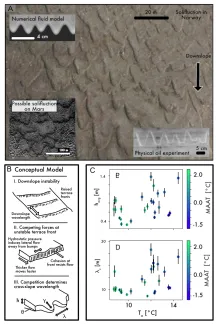Arctic soil patterns analogous to fluid instabilities
Inspired by fluid instabilities, scientists from Los Alamos National LaboratoryLANL developed a new conceptual model for soil patterns and used mathematical analysis to predict their wavelength. These researchers proposed that soil patterns arise due to competition between gravity and cohesion, or the “"stickiness”" of soil grains.
This study informs our understanding of soil rheology, and therefore how soil may respond to changes in climate and hydrologic forcing. This work proposes a new framework for thinking about considering arctic soil stability. Theoretical predictions were compared with a large new data set of soil features from Norway, finding showing that soil patterns are controlled by both fluid-like properties as well as climate. A comprehensive compilation of solifluction velocity profiles found in the literature was conducted and the effective viscosity of soil for field sites across the globe was calculated.
The findings may be used as a launching point to improve modeling efforts that predict cohesion-controlled topographic roughness and its role in modulating hillslope hydrology, slope stability, and carbon storage and release. More broadly, the results provide the first physical explanation for a common pattern on both Earth and Mars, with implications for our understanding of landscapes and complex materials composed of both granular and fluid components.
This research was supported by the Director, Office of Science, Office of Biological and Environmental Research of the US Department of Energy under Contract No. DE-AC02-05CH11231 as part of the Next-Generation Ecosystem Experiments (NGEE Arctic) project.
For more information, please contact:
Rachel Glade
Joel Rowland
jrowland@lanl.gov

